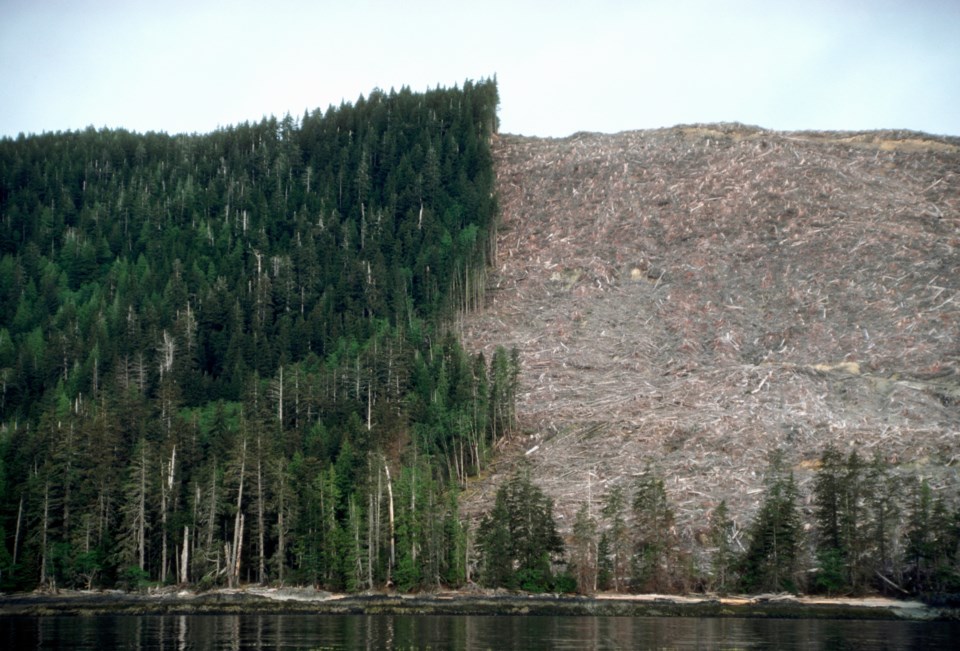This past week, an open-air hearse bearing the corpse of a single slaughtered giant rolled through Nanaimo. It was nothing new, but with public awareness piqued by the Fairy Creek blockades—most recent imbroglio in B.C.’s longstanding old-growth standoff—someone had the presence of mind to snap a photo of this felled behemoth. It went viral, as it should have—the hubris and arrogance surrounding it on display for all to see. I’ve seen trucks like that rolling through Whistler, bearing three, two, or even one log because they’re too large to otherwise accommodate. It made me sick to my stomach each time, and the Nanaimo photo was no different.
B.C. logging blockades have been the stuff of national—and often international—news for half a century. As an evolutionary ecologist who had seen firsthand the inexplicable clearcuts of B.C.’s scant remaining old growth, and who well understood the ravages of anachronistic forest practices, I was predisposed to join the fight. Thus, I came to revere battlegrounds like Haida Gwaii’s South Moresby, and Vancouver Island’s Carmanah Valley, Meares Island, and Clayoquot Sound; my frontline heroes comprised First Nations, the Western Canadian Wilderness Committee, and the Friends of Clayoquot Sound; the enemy was forestry (a.k.a. forest destruction) companies and the toady governments who facilitated them. In my university days in Ontario I dutifully signed on to receive newsletter updates and copies of related government documents. I read a lot. I got angry. From afar I cheered on the thousands who gave enough of a damn to fight for these last redoubts of coastal biodiversity, thousands of years in the making.
Despite some empathy for the loggers—folks just trying to make a living, mostly caught in the middle, and primed by their employers with hollow logaganda talking points—it was hard to fathom the collective industrial-level ignorance required to fell a 1,000-year-old tree with a clear conscience, or the seemingly bizarre entitlement of those who would happily continue such conceit until the last giant lay dead on the forest floor. Fairy Creek is happening now, but the fight that most encapsulated this to the world took place 28 years ago.
On April 13, 1993, after a decade of logging issues in the area, B.C.’s NDP government of the day (sound familiar?) announced a land-use decision for Clayoquot Sound it believed would balance environmental, economic and social needs (First Nations concessions weren’t even included). On paper it reduced B.C.’s odious annual allowable cut by a third and took back 95,000 hectares from forest companies which, added to existing set-asides, protected 33.4 per cent of the land base and sequestered a further 17.6 per cent in “special management areas.” The false magnanimity fooled no one, as it was well understood that 66 per cent of the area remained open to logging. The resulting massive protest saw Clayoquot Sound become another international symbol of all that was wrong with industrial logging—a touchstone for a change in forestry practices that would preserve some of what serves as home to thousands of unique organisms and which should be a heritage birthright for all British Columbians.
The region became the beating heart of a widespread environmental awakening, inspiring large-scale peaceful actions and engendering a strategy since utilized in environmental campaigns around the globe. In addition to government and logging companies, protestors targeted global corporate customers of B.C. products, costing the province millions. The scofflaw logging industry circled its wagons, but to no avail.
Although the protests wrapped in October 1993, this “War in the Woods”—Canada’s largest-ever act of civil disobedience—saw 12,000-plus protesters, 856 arrests (300 in a single day), visiting celebrities like Robert Kennedy Jr., and a spontaneous concert by the political Aussie band, Midnight Oil. While the fight drove a wedge between neighbouring Tofino and Ucluelet, tensions eventually deliquesced into important breakthroughs: the Clayoquot Sound Scientific Panel for Sustainable Forest Practices led to B.C.’s first forest-practices code; Clayoquot’s First Nations signed a groundbreaking agreement under the province’s new treaty system; and the protests influenced future environmental movements, including the Great Bear Rainforest, tar sands, and anti-pipeline campaigns.
As a British Columbian these days, the most important upshot for me was how forest areas I now enjoy were saved by the War in the Woods—a winning cause I plan to uphold in my own community because, make no mistake, old growth is being unjustifiably logged here, too. Fairy Creek isn’t just déjà vu for me but for a generation—and for people like Tzeporah Berman, a resource policy advisor to various governments, International Program Director with Stand.Earth, and Global Chair of the Fossil Fuel Non-Proliferation Treaty Initiative who cut her teeth as blockade coordinator in Clayoquot Sound. Arrested at the time and charged with 857 counts of abetting civil disobedience (she got off all of them), last week she visited the Fairy Creek blockade. She was arrested again, and proud of it. If we’d been allowed to travel this week I would be there, too.
The other day I listened to a call-in show on CBC radio about the blockades and it was pretty much the same as 30 years ago. One side, informed by science: we are literally killing an entire ecosystem that will never regenerate. The other side, informed by entitlement: jobs, jobs, jobs. Well, the bottom line is that loggers have no more right to make a living killing the last ancient giants than commercial fishermen in Newfoundland had to take the last cod when the Atlantic stocks crashed in 1991; in the latter case a moratorium was declared and the fish still haven’t returned. Is that where old growth is going in B.C.?




